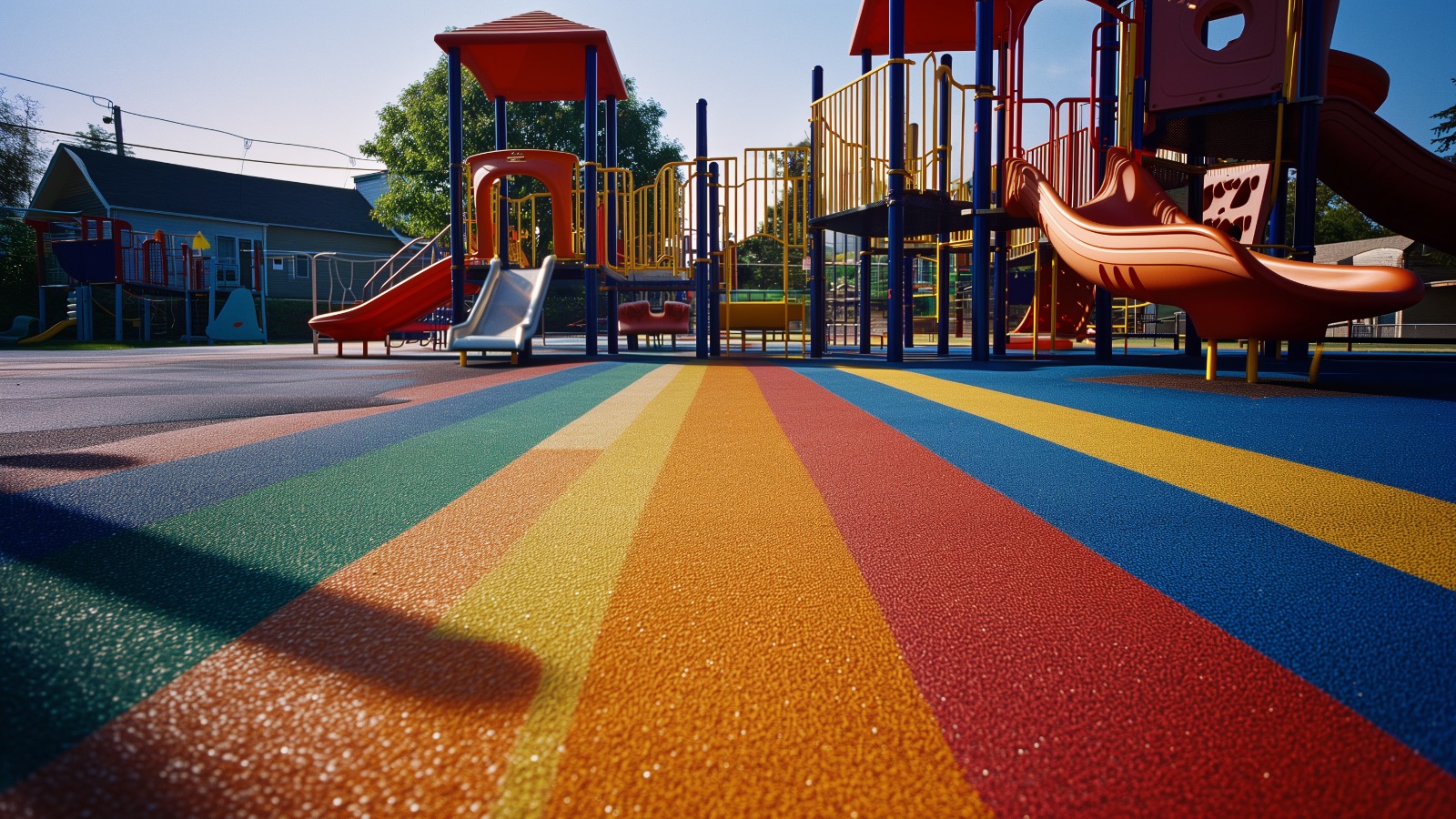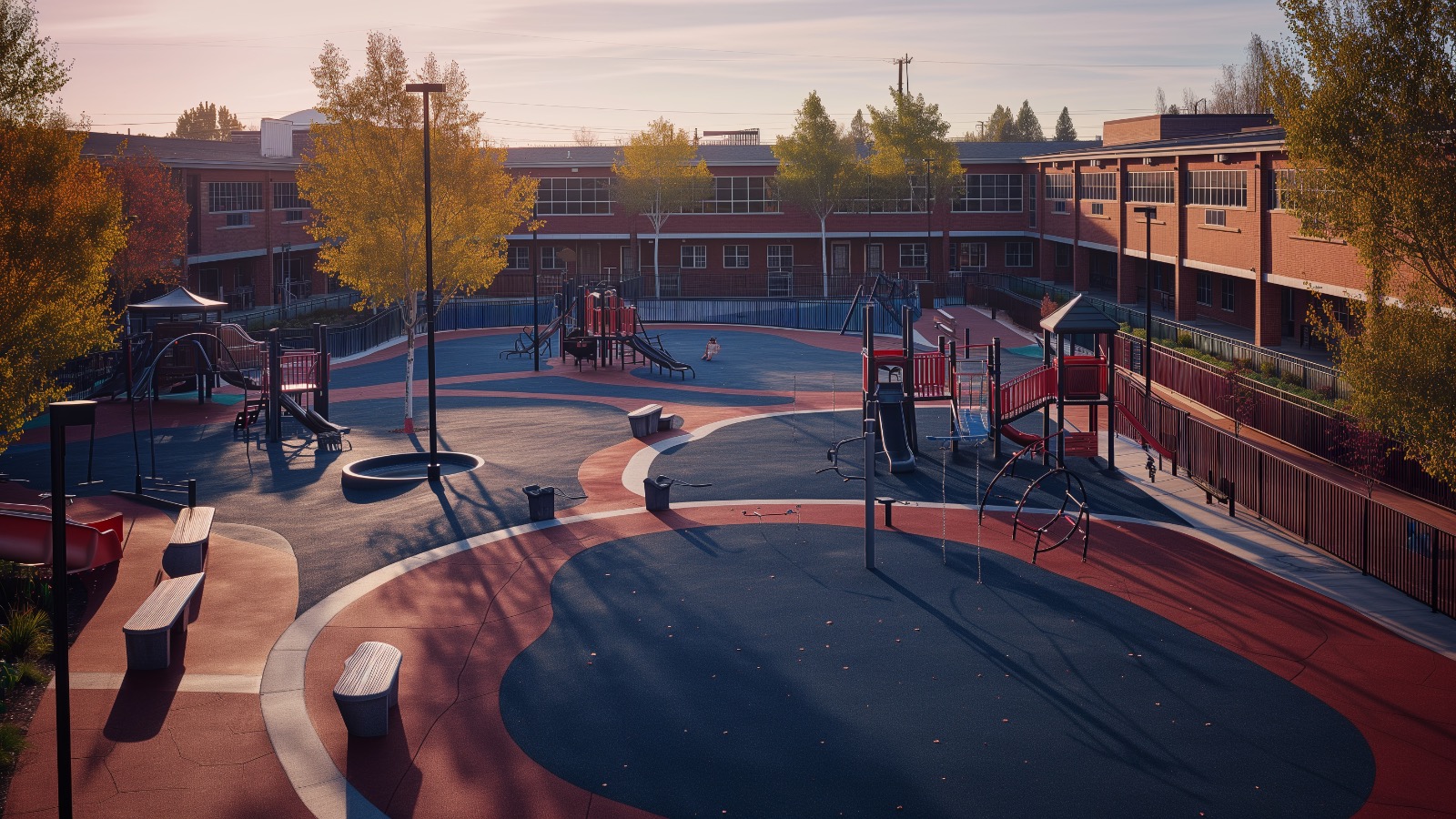2024-01-19
Rubberized Playground Flooring Enhances the Safety and Durability of Playgrounds
In playground safety, the materials used are just as important as the playground equipment itself. One such material that has gained popularity recently is rubberized playground flooring. This innovative surface material offers many benefits, not least its ability to reduce the risk of serious injury among children significantly. But what makes rubber playground surfacing stand out from traditional materials like wood chips or sand? This article will delve into the superior safety features, durability, customization options, and other benefits that make poured-in-place rubber an ideal choice for playgrounds in schools, parks and other play areas.
Rubber playground surfaces, including rubber playground mats and rubber mulch, have revolutionized how we think about playground safety and design. Unlike hard surfaces such as concrete, poured-in-place rubber provides shock absorption and is slip-resistant, significantly decreasing the likelihood of injuries from falls. This is particularly important, considering that most playground injuries result from falls. Using recycled rubber on these surfaces enhances their safety features and contributes to an eco-friendly approach to playground construction.
The selection of playground surfacing material is a crucial decision that impacts the safety and enjoyment of children. With poured rubber surfacing, playground administrators can create a play environment that is both safe and inviting. This article explores the reasons why poured-in-place rubber safety surfacing is becoming the preferred choice for playgrounds across the nation and how it stands out from other types of playground materials like wood chips, sand, or mulch.


Superior Safety of Poured Rubber Flooring
The primary concern for any playground is the safety of the children who play there. Poured-in-place rubber playground surfaces offer a significant advantage in this regard. These surfaces are specifically designed to provide shock absorption, which is critical in reducing the impact of falls. According to studies, the shock-absorbing properties of rubber playground tiles and mats can significantly reduce the severity of injuries compared to traditional playground materials. This is particularly crucial when considering the fall height requirements set by safety standards. Rubberized playground flooring is engineered to meet these standards, ensuring play areas are fun and safe.
Another aspect of safety that poured rubber flooring addresses is the risk of slips and trips. Rubber playground tiles are slip-resistant, even when wet. This feature is especially important in climates where rain or snow can make playground surfaces slick and hazardous. The texture of the rubber surface provides a stable footing, helping to prevent falls and the serious injuries that can result from them.
Impact Attenuation and Fall Height Requirements
One of the key safety features of poured-in-place rubber surfacing is its impact attenuation capability. This refers to the surface’s ability to absorb the energy of a falling child, thus reducing the severity of the impact. Rubber playground surfacing is designed to meet specific fall height requirements, which vary based on the height of playground equipment. Ensuring that these requirements are met and poured in place rubber safety surfacing significantly reduces the risk of serious injuries from falls.


Durability and Customization of Rubber Playground Flooring
Durability is another significant advantage of poured rubber playground surfaces. These materials are designed to withstand heavy use and harsh weather conditions without considerable wear and tear. Unlike wood chips or sand, which must be replenished regularly, poured rubber flooring maintains its integrity over time. This makes it a cost-effective solution in the long run, as it requires less maintenance and replacement compared to other playground surfacing options.
Customization is a key feature that sets poured rubber surfacing apart. The material is highly customizable in terms of color and design options. This allows playground designers to create unique, visually appealing play areas incorporating educational elements, games, or specific themes. Such customization enhances the playground area’s aesthetic appeal and contributes to the overall play experience for children.
Eco-Friendly Material and Design Flexibility
Poured-in-place rubber is often recycled, making it an eco-friendly choice for playground surfacing. Using recycled materials contributes to environmental sustainability while providing a safe play surface. Additionally, the flexibility in design that poured rubber offers allows playgrounds to be tailored to fit any shape or size, making it an ideal choice for playgrounds with irregular layouts or specific design requirements.


Cost-Effectiveness and Accessibility
When considering the installation of a new playground surface, the cost and installation process are important factors. Poured-in-place rubber, while initially more costly than wood chips or sand materials, offers long-term savings due to its durability and low maintenance requirements. The installation process is carried out by professionals who ensure that the surface is evenly distributed and meets all safety standards. This professional installation is crucial for achieving optimal playground surface performance in terms of safety and durability.
In addition to safety and durability, poured rubber playground surfacing also offers benefits in terms of accessibility. This unitary rubber playground surface allows children of all abilities to play safely and comfortably. It provides a stable and even surface, essential for children who use mobility aids. This inclusivity is a significant step in playground design, ensuring that all children can play and interact in a safe environment.
Versatility in Application Across Various Playgrounds
The versatility of poured rubber surfaces extends beyond traditional playgrounds. They are also ideal for use in other play areas, such as parks, daycares, and church grounds. The material’s ability to be molded into various shapes and designs makes it suitable for different environments, ensuring that every play area can benefit from its safety and aesthetic properties.


Embracing the Future of Playground Safety
Rubberized playground flooring significantly advances playground safety and design. Its superior safety features, including impact attenuation and slip resistance, make it the best surface choice for protecting children from serious injuries. The durability and customization options of poured-in-place rubber ensure that playgrounds are safe, durable, visually appealing and engaging for children.
Using poured-in-place rubber is a matter of safety, aesthetics and future investment. By choosing this material, playground and park administrators are opting for a long-lasting, maintenance-friendly surface that will serve the needs of children for years to come. Furthermore, the eco-friendly nature of recycled rubber contributes to a greener, more sustainable approach to playground construction.
As communities continue to prioritize the safety and well-being of their children, rubberized playground flooring stands out as the optimal choice. Whether installed for a school, park, or church playground, this material offers the best safety, durability and design flexibility. By installing rubber playground surfacing, we can ensure children have a safe and enjoyable space to play, grow, and learn.














